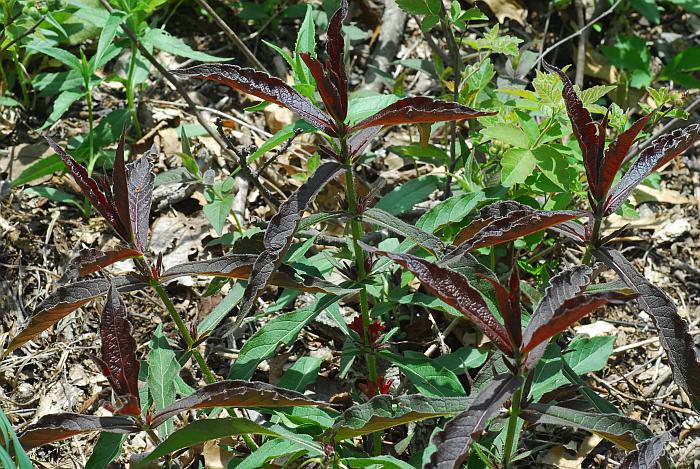Triosteum angustifolium L.
Yellow-Flowered Horse Gentian

Native
CC = 6
CW = 3
MOC = 36
© SRTurner
Triosteum angustifolium L.Yellow-Flowered Horse Gentian | |
 |
Native CC = 6 CW = 3 MOC = 36 |
© SRTurner |
|
Family - Caprifoliaceae Habit - Perennial forb. Stem - Ascending to erect, to 70 cm, moderately to densely pubescent with straight, spreading to somewhat downward-angled, stiff, bristly hairs 1.5-3.0 mm long, these sometimes mixed with shorter, softer hairs that are all or mostly minutely gland-tipped.
Leaf - Leaves opposite, typically decussate, not perfoliate, the bases joined only by a small ridge around the stem. Leaf blades 10-19 cm long, 2.0-5.5 cm wide, oblanceolate to narrowly rhombic or narrowly elliptic, tapered at the base, sometimes to an indistinct, broadly winged petiolar base, tapered to a sharply pointed tip, the margins with relatively dense, stiff, ascending hairs, the upper surface moderately pubescent with long, straight, appressed hairs, the undersurface sparsely to moderately pubescent with stiff, spreading hairs along the veins or less commonly moderately to densely and uniformly pubescent with short, soft hairs.
Inflorescence - Flowers usually solitary in leaf axils (2 per node). Flowers - Sepals 5, 9-12 mm long, surfaces glabrous or nearly so, margins with long, bristly hairs. Corollas usually yellow but occasionally orange or red, 13-17 mm long, narrowly funnelform, the mouth noticeably oblique, the outer surface with glandular hairs. Style exserted from corolla <2 mm.
Fruits - Fruits 5-7 mm in diameter, yellow-orange, moderately to densely hairy at maturity.
Flowering - April - May. Habitat - Forests, bases and ledges of bluffs, streambanks. Origin - Native to North America. Lookalikes - T. perfoliatum, T. aurantiacum. Other info. - Of the three horse gentians found in Missouri, this is the least common. It is restricted to the southern half of the state. Beyond Missouri its range extends eastward in a scattered fashion. The common name is unfortunate, since although the flowers are typically yellow, red-flowered specimens are common enough that corolla color is not a reliable criterion for identification. Characters pointing to T. angustifolium include 1) narrow leaves; 2) relatively long stem hairs, many of which are as long as the width of the sepals, and which are usually nonglandular; 3) noticeably bristly sepal margins. The red-flowered form has been called fo. rubrum F. Lane. Some authors have also split the species into two varieties based upon the pubescence of the leaf abaxial surface. Photographs taken at Valley View Glade Natural Area, Jefferson County, MO, 4-28-2010 and 5-8-2017, and at Young Conservation Area, Jefferson County, MO, 4-22-2015 (SRTurner). |